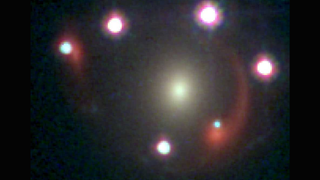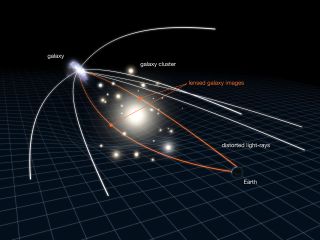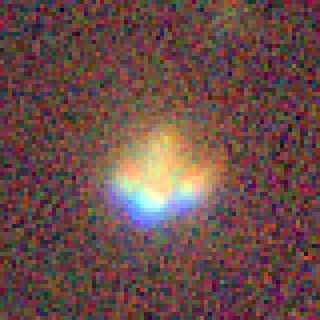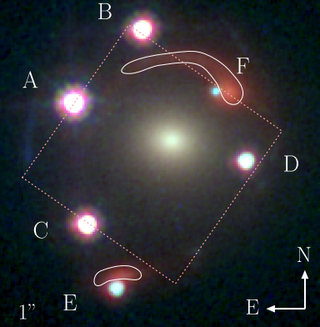“This unique lensing configuration allows us to constrain both the Hubble constant and dark energy parameters simultaneously—something that is generally not possible.”

Six instances of the same quasar in one JWST image indicate the discovery of the first Einstein zigzag. (Image credit: Dux et al., 2024)
Using the James Webb Space Telescope, astronomers have discovered the first “Einstein zig-zag,” an image of one quasar repeated six times in a single image. The arrangement was created thanks to an effect first proposed by Albert Einstein in 1915 called “gravitational lensing,” and it could help scientists avert a crisis in cosmology.
This system, designated J1721+8842, is comprised of a quasar, which is an extremely luminous galactic core — lensed by two widely separated, but perfectly aligned, galaxies. Not only is this sighting incredibly rare, marking a fascinating example of a curious spacetime-bending phenomenon introduced in Albert Einstein’s magnum opus theory of gravity, general relativity, but the J1721+8842 zig-zag also has a power that standard gravitational lenses don’t.
The first Einstein zigzag seen by humanity could help scientists tackle two of cosmology’s greatest mysteries. The first mystery concerns is the nature of dark energy, or the force driving the accelerating expansion of the universe that accounts for around 70% of the cosmic energy and matter budget, and the second has to do with a disparity scientists find when measuring the value of the speed of the universe’s expansion: the Hubble constant.
“I am thrilled, not only because this is a fascinating natural phenomenon but also because this system is incredibly promising for measuring cosmological parameters,” Martin Millon, a discovery team member and a Stanford University cosmologist, told Space.com. “This lens system offers the potential to place stringent constraints on both the Hubble constant and the dark energy equation of state, something that is generally not possible.”
What is a gravitational lens anyway?
General relativity states that objects with mass cause a curvature in the very fabric of space and time, united as a single entity called “spacetime.” The greater the mass of an object, the greater the “dent” it causes in spacetime. As gravity arises from this curvature, the more mass an object has, the larger its gravitational influence.
Gravitational lensing occurs when light from a background source travels past a massive lensing body on its way to Earth and therefore follows the resulting curvature in space, causing its own path to curve. The light from this background source thus takes different paths around a gravitational lens, approaching the lensing mass at varying distances and being curved in different amounts. This means this light from the same background source can arrive at different times to the same telescope.
As a result, a single background light-emitting body can appear at multiple places in a single image. These objects can form arrangements like Einstein rings, Einstein crosses, and, in this currently unique case, an Einstein zig-zag.

The JWST wasn’t actually the first telescope to spot J1721+8842. The lensed quasar, which is more specifically composed of brightly glowing gas and dust around a feeding supermassive black hole, was spotted by Cameron Lemon in 2017 using the Panoramic Survey Telescope and Rapid Response System (Pan-STARRS) located at Haleakala Observatory in Hawaii.
At first, the quasar appeared to be lensed just four times. However, the sensitivity of the JWST has revealed that two galaxies are actually lensing this distant quasar six times, with the more distant galaxy in this arrangement also being lensed by the closer galaxy.
“Typically, gravitational lenses created by a single galaxy form either two or four images of the background source, depending on the alignment. In this case, there is an exceptional alignment between two galaxies and a background quasar, forming a rare six-image configuration.” “We called it an ‘Einstein zigzag’ because the optical path of two of the multiple images passes by the first galaxy on one side before being deflected by the second galaxy on the other side. This optical path creates a zigzag pattern between the two galaxies.”

Research lead author and EPFL Laboratory of Astrophysics scientist Frédéric Dux told Space.com that this is the first time that scientists have found such a perfect alignment between three different bodies that create a gravitational lens.
“Typically, a gravitational lens would involve only two objects, say a galaxy acting as a lens and another galaxy behind, acting as a source, whose light is bent by the foreground one,” Dux said. “Of course, there are many instances of lensing occurring due to multiple galaxies at once, such as in galaxie cluster lenses. In those cases, the effects of the different deflectors are combined in a weak way. You wouldn’t find a single galaxy acting as a perfect lens on its own. The alignment just isn’t good enough.”
That isn’t the case with J1721+8842, though.
The closest galaxy in this lens is so distant that its light has been traveling to Earth for 2.3 billion years, while light from the more distant galaxy has been traveling to us for 10 billion years. Yet, despite the vast distance between these two galaxies, Dux said they provide an alignment so good that they both act to detect light from a quasar source located around 11 billion light-years away, while the foreground galaxy also acts to lens light from the intermediate galaxy.
“This is rare. We expect that one in 50,000 lensed quasars would have such a configuration… and we only know of about 300 lensed quasars in total, so we were very lucky to find this one!” Dux said. “We might not find another one for a long time, if ever.”
Einstein zig-zag could address a cosmological crisis
Dux explained that the team is already working on updated models of J1721+8842 to measure the Hubble constant.
“Most lensed quasars can be used for this purpose, but the fact that this one has two different lenses makes the lensing model a lot better constrained, and the uncertainty in the Hubble constant value will be smaller,” Dux said. “This is very interesting in a time when cosmology is in a potential crisis due to what we call the Hubble tension.”
The Hubble tension arises from the fact that measuring the Hubble constant in the very early universe and extrapolating the evolution of this value forward through 13.8 billion years of cosmic history (using the best cosmological model) should lead to the same value that astronomers measure when they observe the local universe and thus measure the Hubble constant at its current age. However, there is a strong disparity between the two results.
“There could be measurement errors in either, so before declaring a definite crisis, we need to keep hunting for potential errors and refining our measurements,” Dux said.
By reducing the uncertainties in these measurements, this Einstein zig-zag lens could bring the arrived-at value and the observed value of the Hubble constant closer together.

“Additionally, this lens can also be used simultaneously to constrain the equation of the state of dark energy in the universe,” Dux said. “This is very interesting as this quantity and the Hubble constant are typically degenerate, meaning we can’move both knobs’ in different directions and still fit the observational data well. With this system, we might be able to break this degeneracy.”
That would allow for both values to be determined simultaneously using J1721+8842, something generally not possible. The researcher added that this is something presently in progress, but much theoretical work and technical infrastructure development are needed before the team can measure the two values they want to examine in a “safe” way, avoiding potential biases and errors.
“J1721+8842 has other applications, such as studying the more distant lensing galaxy,” Dux said. “Because it acts both as a lens and as a light source, appearing as the distorted red arc, we can precisely infer its mass. We also have a beautiful spectrum from the JWST observation to study this galaxy’s star formation history and the clumpiness of its matter. This is the first real chance to answer such questions for a galaxy this far away.”
Although the JWST was integral in discovering the true nature of J1721+8842 as an Einstein zigzag, it may not be the best instrument for hunting for more of these elusive arrangements.
“The JWST provides crazily deep observations for small patches of the sky. For the discovery of more Einstein zigzags, we need to survey the entire sky,” Dux said. “Gaia and sky surveys, such as Pan-STARRS, Euclid, or the future Vera Rubin Observatory Legacy Survey of Space and Time (LSST), are the right tools for this search.
“We will keep looking for lensed quasars! We expect to find many more with the Vera Rubin LSST and the Euclid mission. Whether we stumble across another zigzag will be a matter of luck.”
The team’s research is available in preprint on the paper repository arXiv.


